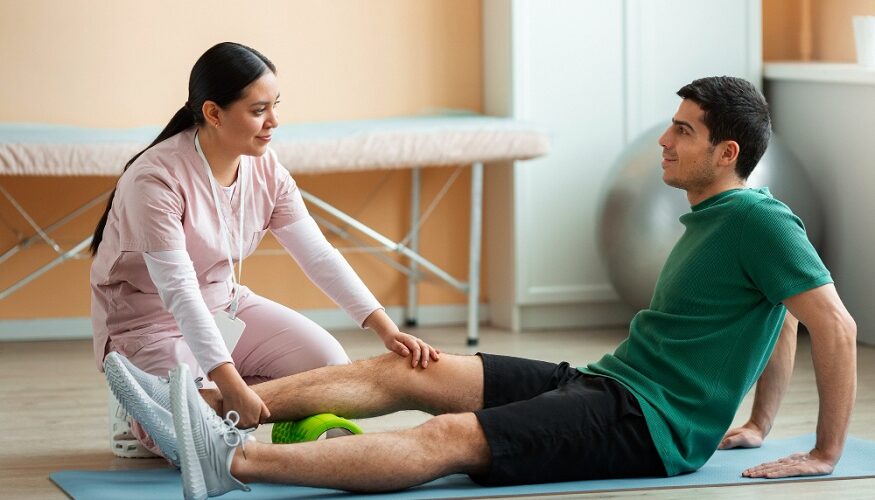When people think of wrist and hand pain, carpal tunnel syndrome usually takes the spotlight. But there’s another condition that can cause tingling, weakness, and discomfort on the little finger side of the hand — Guyon’s Canal Syndrome. This lesser-known problem involves compression of the ulnar nerve at the wrist, and while it can sound alarming, the right treatment approach can make all the difference.
Physiotherapy is often the best starting point for managing this condition, helping to ease symptoms, restore function, and reduce the likelihood of recurrence. Let’s break down why physiotherapy should be your first step if you’re dealing with Guyon’s Canal Syndrome.
What Is Guyon’s Canal Syndrome?
Guyon’s Canal Syndrome occurs when the ulnar nerve is compressed in a narrow space at the wrist known as Guyon’s canal. This nerve supplies sensation to the little finger and half of the ring finger, as well as motor control to several important hand muscles.
When it’s pinched, people may notice:
- Tingling or numbness in the ring and little fingers
- Weakness when spreading or gripping with the fingers
- Hand fatigue during tasks that require fine motor control
- Pain on the ulnar side of the wrist
It’s sometimes called “handlebar palsy” because cyclists are especially prone to it due to pressure from handlebars on long rides. But anyone exposed to repetitive wrist strain, vibration, or direct pressure can develop the problem.
Signs and Symptoms
The way this condition presents can vary depending on where the nerve is pinched inside the canal, but common signs include:
- Numbness or tingling in the ring and little fingers
- Burning or sharp pain on the pinky side of the wrist and hand
- Weak grip strength, particularly when pinching or spreading the fingers
- Clumsiness or hand fatigue during fine motor tasks such as writing or buttoning clothes
- In more advanced cases, wasting of small hand muscles around the thumb base and between the fingers
These symptoms often worsen with activities that put pressure on the wrist, such as cycling, using tools, or leaning on a desk for extended periods.
Why Physiotherapy First?
For most cases of Guyon’s Canal Syndrome, surgery isn’t immediately necessary. In fact, starting with Beechboro Physiotherapy has several advantages:
- Accurate assessment: A physiotherapist can identify whether symptoms stem from nerve compression at the wrist, or if the irritation begins higher up, such as at the elbow or neck.
- Conservative management: Many people improve with guided exercise, ergonomic advice, and manual techniques, avoiding the need for invasive treatment.
- Targeted rehabilitation: Physiotherapy focuses not only on symptom relief but also on restoring strength, dexterity, and endurance in the hand.
- Holistic care: Your wrist doesn’t work in isolation. A good therapist will consider posture, shoulder strength, and even cycling technique in their approach.
Treatment Options in Physiotherapy
A tailored program will depend on the severity of symptoms and your lifestyle demands, but commonly used physio Beechboro strategies include:
- Activity and Ergonomic Advice
- Reducing pressure on the wrist is a key first step. That might involve adjusting bike handlebars, using padded gloves, or modifying work practices.
- Manual Therapy
- Physiotherapists often use gentle mobilisation of the wrist and surrounding joints, along with soft tissue techniques to reduce tightness and improve nerve mobility.
- Nerve Gliding Exercises
- Specialised movements can help the ulnar nerve move more freely within the canal, reducing irritation and improving circulation to the nerve.
- Strengthening and Conditioning
- Exercises for the small hand muscles and forearm stabilisers restore grip and control, while broader conditioning may address shoulder and postural imbalances.
- Education and Prevention
- Learning how to pace tasks, improve wrist alignment, and integrate micro-breaks can protect against recurrence.
Beyond the Wrist: A Whole-Body View
It’s important to remember that nerve symptoms in the hand can sometimes be linked to issues higher up the chain. Neck stiffness, shoulder weakness, and poor posture can all increase the strain on the ulnar nerve.
That’s why physiotherapists don’t just look at your wrist in isolation. They’ll assess how you move, sit, and work to uncover contributing factors. This is especially relevant if you’re involved in repetitive or high-load activities, such as cycling, construction work, or sports training.
In fact, many people benefit from the principles of sports physiotherapy, where treatment blends rehabilitation with performance. This approach ensures you’re not only pain-free but also strong enough to handle the physical demands of your lifestyle.
When to Seek Professional Help
Guyon’s Canal Syndrome rarely resolves on its own if the underlying compression continues. Early intervention makes treatment simpler and reduces the risk of long-term muscle weakness. Signs you should see a Beechboro musculoskeletal physio include:
- Persistent numbness or tingling in the ring and little fingers
- Weak grip or clumsiness when handling objects
- Pain or discomfort on the ulnar side of the wrist that doesn’t improve with rest
If you’re experiencing any of these symptoms, don’t delay.
Guyon’s Canal Syndrome can feel disruptive, especially if it affects your work, hobbies, or daily activities. But with physio near me as the first step, many people find relief and regain hand function without the need for invasive treatment.
From ergonomic adjustments to targeted exercises and education, physiotherapists are uniquely positioned to guide recovery. Whether you’re a cyclist struggling with handlebar palsy, a tradesperson with wrist strain, or simply someone noticing new tingling in the hand, early treatment is key.
Physiotherapy puts you back in control so your hands can keep up with the demands of everyday life.

